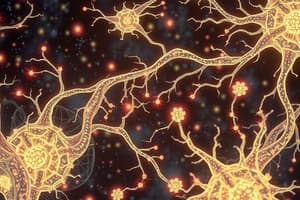Podcast
Questions and Answers
What contributes to the existence of the resting membrane potential in neurons?
What contributes to the existence of the resting membrane potential in neurons?
- Active transport of ions through voltage-gated channels
- An equal buildup of negative ions inside and outside the membrane
- The predominance of sodium ions in the cytosol compared to potassium ions
- A small buildup of negative ions in the cytosol and positive ions in the extracellular fluid (correct)
In terms of electrical signaling in neurons, how do graded potentials differ from action potentials?
In terms of electrical signaling in neurons, how do graded potentials differ from action potentials?
- Graded potentials involve the opening of voltage-gated channels, while action potentials do not
- Action potentials are always of the same magnitude regardless of stimulus strength, while graded potentials vary in magnitude (correct)
- Action potentials are summative effects of graded potentials over time
- Graded potentials can travel long distances while action potentials are restricted to short distances
What is the primary role of ion channels in excitable cells?
What is the primary role of ion channels in excitable cells?
- To allow specific ions to move across the membrane, contributing to electrical signaling (correct)
- To generate ATP for energy needs
- To maintain the resting membrane potential only
- To provide structural support to the plasma membrane
What is the voltage range typically associated with the resting membrane potential in neurons?
What is the voltage range typically associated with the resting membrane potential in neurons?
How does the flow of ions across the membrane relate to the concept of electrical current in living cells?
How does the flow of ions across the membrane relate to the concept of electrical current in living cells?
Which of the following types of ion channels primarily regulate the flow of ions based on the binding of specific molecules?
Which of the following types of ion channels primarily regulate the flow of ions based on the binding of specific molecules?
What feature of the plasma membrane facilitates the flow of current in excitable cells?
What feature of the plasma membrane facilitates the flow of current in excitable cells?
What characterizes action potentials in comparison to graded potentials?
What characterizes action potentials in comparison to graded potentials?
Flashcards are hidden until you start studying
Study Notes
Resting Membrane Potential
- The resting membrane potential results from an imbalance of ions across the cell membrane, with a higher concentration of negative ions inside the cell and positive ions outside.
- Neuron resting membrane potential typically ranges from -40 to -90 millivolts (mV), with a typical value being -70 mV.
- A cell exhibiting a membrane potential is said to be polarized.
Electrical Signals in Neurons
- Neurons are electrically excitable, meaning they can respond to stimuli and convert them into nerve impulses.
- Two types of electrical signals are used for communication:
- Graded potentials: Used for short-distance communication.
- Action potentials: Used for long-distance communication.
Ion Channels
- Ion channels are integral membrane proteins that allow specific ions to move across the cell membrane.
- The movement of ions is driven by their electrochemical gradient, consisting of both concentration and electrical differences.
- Ion channels are regulated by "gates," which can open and close the channel pore.
Types of Ion Channels
- Leak channels: Always open and allow a small flow of ions across the membrane.
- Ligand-gated channels: Open or close in response to binding of a specific chemical messenger.
- Mechanically gated channels: Open or close in response to physical deformation of the membrane.
- Voltage-gated channels: Open or close in response to changes in the membrane potential.
Studying That Suits You
Use AI to generate personalized quizzes and flashcards to suit your learning preferences.



